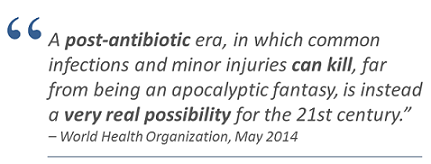While antibiotics are necessary and crucial for treating bacterial infections, their misuse over time has contributed to a rather alarming rate of antibiotic resistance, including the development of multidrug-resistance bacteria or “super bugs.” Misuse manifests throughout all corners of public and private life; from the doctor’s office when prescribed to treat viruses; to industrial agriculture, where they are used in abundance to prevent disease in livestock. New data from the World Health Organization (WHO) and U.S. Centers for Disease Control and Prevention (CDC) confirm that rising overuse of antibiotics has already become a major public health threat worldwide.

As drug resistance increases, we will see a number of dangerous and far-reaching consequences. First, common infections like STDs, pneumonia, and “staph” infections will become increasingly difficult to treat, and in extreme cases these infections may require hospitalization or treatment with expensive and toxic second-line therapies. In fact, recent estimates suggest that every year more than 23,000 people die due to drug-resistant infections in the U.S., and many more suffer from complications caused by resistant pathogens. Further, infections will be harder to control. Health care providers are increasingly encountering highly resistant infections not only in hospitals – where such infections can easily spread between vulnerable patients – but also in outpatient care settings.
Fundamental Approaches to Slowing Resistance
Incentivize appropriate use of antibiotics. Many patients and providers underestimate the risks of using antibiotics when they are not warranted, in part because these drugs often have rapid beneficial effects for those who truly need them. In many parts of the world the perception that antibiotics carry few risks has been bolstered by their low costs and availability without a prescription or contact with a trained health care provider. Education efforts, stewardship programs, and the development of new clinical guidelines have shown some success in limiting antibiotic use, but these fixes are limited in scope and generally not perceived as cost-effective or sustainable. Broader efforts to incentivize appropriate use, coupled with economic incentives, may be more effective in changing the culture of antibiotic use. These options might include physician or hospital report cards that help impact patient provider selection, or bonuses based on standardized performance measures that can be used to report on success of promoting appropriate use. While these might create additional costs, they would likely help control rates of drug resistant infections and outweigh the costs of treating them.
Reinvigorate the drug development pipeline with novel antibiotics. There has not been a new class of antibiotics discovered in almost three decades, and companies have largely left the infectious disease space for more stable and lucrative product lines, such as cancer and chronic disease. Antibiotics have historically been inexpensive and are typically used only for short periods of time, creating limited opportunities for return on investment. In addition, unlike cancer or heart disease treatments, antibiotics lose effectiveness over time, making them unattractive for investment. Once they are on the market, the push to limit use of certain antibiotics to the most severe infections can further constrict an already weak market.
Late last year, H.R. 3742, the Antibiotic Development to Advance Patient Treatment (ADAPT) Act of 2013, was introduced and referred to the House Energy and Commerce Subcommittee on Health. If enacted, the ADAPT Act would create a streamlined development pathway to expedite the approval of antibiotics that treat limited patient populations with serious unmet medical needs. This could potentially reduce costs and development time for companies, thereby encouraging investment in this space. Regulators have indicated that they would also welcome the opportunity to evaluate benefits and risk for a more selective patient subpopulation if they could be confident the product would be used appropriately. The bill has received a great deal of support and would help address a critical public health need.
Advance new economic incentives to remedy market failure. Innovative changes to pharmaceutical regulation, research and development (R&D), and reimbursement are necessary to alleviate the market failure for antibacterial drugs. A major challenge, particularly within a fee-for-service or volume-based reimbursement system, is providing economic incentives that promote investment in drug development without encouraging overuse. A number of public and private stakeholders, including the Engelberg Center for Health Care Reform and Chatham House’s Centre on Global Health Security Working Group on Antimicrobial Resistance, are exploring alternative reimbursement mechanisms that “de-link” revenue from the volume of antibiotics sold. Such a mechanism, combined with further measures to stimulate innovation, could create a stable incentive structure to support R&D.
Improve tracking and monitoring of resistance in the outpatient setting. There is increasing concern about much less rigorous surveillance capabilities in the outpatient setting, where drug-resistant infections are also on the rise. Policymakers should consider new incentives for providers and insurers to encourage a coordinated approach for tracking inpatient and outpatient resistance data. The ADAPT Act, mentioned above, also seeks to enhance monitoring of antibiotic utilization and resistance patterns. Health insurance companies can leverage resistance-related data linked to health care claims, while providers can capture lab results in electronic health records. Ultimately, this data could be linked to health and economic outcomes at the state, federal, and international levels, and provide a more comprehensive population-based understanding of the impact and spread of resistance. Current examples include the Food and Drug Administration’s (FDA) Sentinel Initiative and the Patient-Centered Outcomes Research Institute’s PCORnet initiative.
Antibiotic resistance is an urgent and persistent threat. As such, patients and providers will continue to require new antibiotics as older drugs are forced into retirement by resistant pathogens. Stewardship efforts will remain critical in the absence of game-changing therapies that parry resistance mechanisms. Lastly, a coordinated surveillance approach that involves diverse stakeholder groups is needed to understand the health and economic consequences of drug resistance, and to inform antibiotic development and stewardship efforts.



Commentary
The Path of Least [Antibiotic] Resistance
May 22, 2014